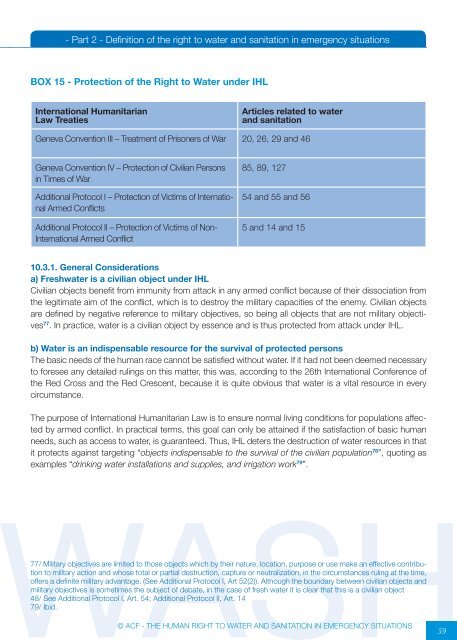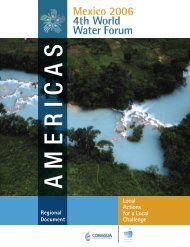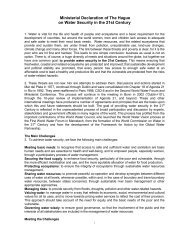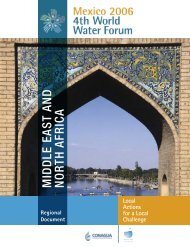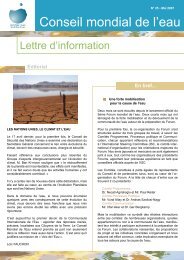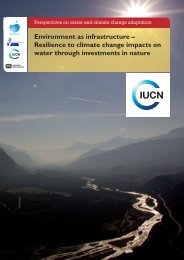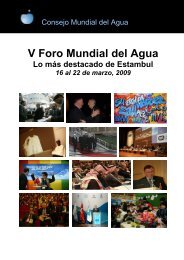the human right to water and sanitation in emergency situations
the human right to water and sanitation in emergency situations
the human right to water and sanitation in emergency situations
You also want an ePaper? Increase the reach of your titles
YUMPU automatically turns print PDFs into web optimized ePapers that Google loves.
- Part 2 - Def<strong>in</strong>ition of <strong>the</strong> <strong>right</strong> <strong>to</strong> <strong>water</strong> <strong>and</strong> <strong>sanitation</strong> <strong>in</strong> <strong>emergency</strong> <strong>situations</strong><br />
BoX 15 - Protection of <strong>the</strong> Right <strong>to</strong> Water under IHL<br />
International Humanitarian<br />
Law Treaties<br />
Articles related <strong>to</strong> <strong>water</strong><br />
<strong>and</strong> <strong>sanitation</strong><br />
Geneva Convention III – Treatment of Prisoners of War 20, 26, 29 <strong>and</strong> 46<br />
Geneva Convention IV – Protection of Civilian Persons<br />
<strong>in</strong> Times of War<br />
Additional Pro<strong>to</strong>col I – Protection of Victims of International<br />
Armed Conflicts<br />
Additional Pro<strong>to</strong>col II – Protection of Victims of Non-<br />
International Armed Conflict<br />
85, 89, 127<br />
54 <strong>and</strong> 55 <strong>and</strong> 56<br />
5 <strong>and</strong> 14 <strong>and</strong> 15<br />
10.3.1. General Considerations<br />
a) Fresh<strong>water</strong> is a civilian object under IHL<br />
Civilian objects benefit from immunity from attack <strong>in</strong> any armed conflict because of <strong>the</strong>ir dissociation from<br />
<strong>the</strong> legitimate aim of <strong>the</strong> conflict, which is <strong>to</strong> destroy <strong>the</strong> military capacities of <strong>the</strong> enemy. Civilian objects<br />
are def<strong>in</strong>ed by negative reference <strong>to</strong> military objectives, so be<strong>in</strong>g all objects that are not military objectives<br />
77 . In practice, <strong>water</strong> is a civilian object by essence <strong>and</strong> is thus protected from attack under IHL.<br />
b) Water is an <strong>in</strong>dispensable resource for <strong>the</strong> survival of protected persons<br />
The basic needs of <strong>the</strong> <strong>human</strong> race cannot be satisfied without <strong>water</strong>. If it had not been deemed necessary<br />
<strong>to</strong> foresee any detailed rul<strong>in</strong>gs on this matter, this was, accord<strong>in</strong>g <strong>to</strong> <strong>the</strong> 26th International Conference of<br />
<strong>the</strong> Red Cross <strong>and</strong> <strong>the</strong> Red Crescent, because it is quite obvious that <strong>water</strong> is a vital resource <strong>in</strong> every<br />
circumstance.<br />
The purpose of International Humanitarian Law is <strong>to</strong> ensure normal liv<strong>in</strong>g conditions for populations affected<br />
by armed conflict. In practical terms, this goal can only be atta<strong>in</strong>ed if <strong>the</strong> satisfaction of basic <strong>human</strong><br />
needs, such as access <strong>to</strong> <strong>water</strong>, is guaranteed. Thus, IHL deters <strong>the</strong> destruction of <strong>water</strong> resources <strong>in</strong> that<br />
it protects aga<strong>in</strong>st target<strong>in</strong>g “objects <strong>in</strong>dispensable <strong>to</strong> <strong>the</strong> survival of <strong>the</strong> civilian population 78 ”, quot<strong>in</strong>g as<br />
examples “dr<strong>in</strong>k<strong>in</strong>g <strong>water</strong> <strong>in</strong>stallations <strong>and</strong> supplies, <strong>and</strong> irrigation work 79 ”.<br />
77/ Military objectives are limited <strong>to</strong> those objects which by <strong>the</strong>ir nature, location, purpose or use make an effective contribution<br />
<strong>to</strong> military action <strong>and</strong> whose <strong>to</strong>tal or partial destruction, capture or neutralization, <strong>in</strong> <strong>the</strong> circumstances rul<strong>in</strong>g at <strong>the</strong> time,<br />
offers a def<strong>in</strong>ite military advantage. (See Additional Pro<strong>to</strong>col I, Art 52(2)). Although <strong>the</strong> boundary between civilian objects <strong>and</strong><br />
military objectives is sometimes <strong>the</strong> subject of debate, <strong>in</strong> <strong>the</strong> case of fresh <strong>water</strong> it is clear that this is a civilian object<br />
48/ See Additional Pro<strong>to</strong>col I, Art. 54; Additional Pro<strong>to</strong>col II, Art. 14<br />
79/ Ibid.<br />
© ACF - THE HUMAN RIGHT TO WATER AND SANITATION IN EMERGENCY SITUATIONS<br />
59


